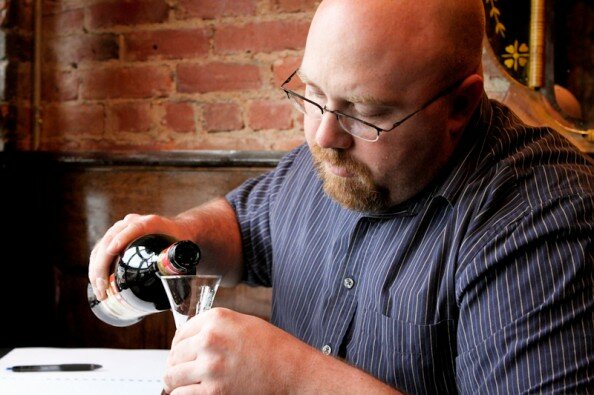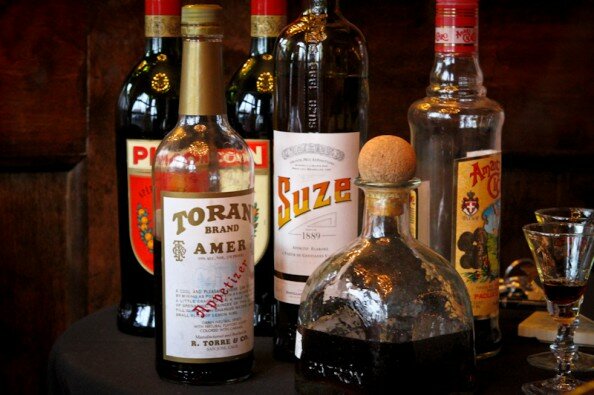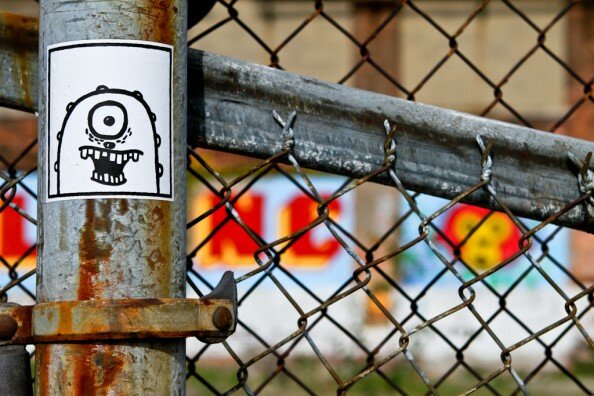
Monthly Archives: May 2012
Gourmet Underground Detroit's content archives are organized by date and catalog the aggregated content of our Features pages as well as our blog.
Lincoln Street
The first time I hung out at Lincoln Street Art Park was a couple of days before Halloween last year on a crisp autumn evening. The park’s founders were throwing a dedication party to celebrate the completion of the project’s first phase. We ate, drank, listened to tunes, and hung out around a pallet fire while the Amtrak Wolverine Service sped past a mere thirty feet away and a dazzling sundown filled the sky with orange and pink. It was a good day.
Subsequent impromptu bonfires saw us toasting ham and cheese sandwiches in a hobo pie maker or bidding farewell to winter by burning dried-up Christmas trees while Charley Marcuse, also known as Detroit’s singing hot dog man at Comerica Park, presented a speech rousing enough to complement the 20 foot high column of flames.
Pallet fires and trains and interesting people are enough to make a place appealing. At Lincoln Street, there’s also the art, from murals that cover entire walls to small ink drawings on random cinder blocks. There are graffiti tags, metal sculptures, stencils, and stickers. A frequent sightseer with a keen eye will find something new every time they visit. It’s a unique place, so I figured that more people should know about it and have the kind of fun I was having. With this in mind, Gourmet Underground Detroit organized our first event of the year – a late April potluck brunch.
 Those who were paying attention to the Facebook event page chatter would have thought that the potluck was going to be a meatfest. And it was: Bob Perye from Rouge Estate was on hand with his smoker and more pulled pork than we could eat. He came armed with four different homemade sauces to complement the tender pork. He was also serving decadent slices of pork wrapped pork wrapped in pork, aka “FrankenBacon”, provided by Tim Idzikowski of Detroit BBQ Company. John Schoeniger of Porktown was grilling sauerbraten sliders while sipping on a fine German weisse bier. And someone even brought a party pack of Cajun fried turkey wings from the nearby Turkey Grill. This place has been on my radar for a couple of years now, but the potluck was the first chance I’ve had to taste the wings. They did not disappoint.
Those who were paying attention to the Facebook event page chatter would have thought that the potluck was going to be a meatfest. And it was: Bob Perye from Rouge Estate was on hand with his smoker and more pulled pork than we could eat. He came armed with four different homemade sauces to complement the tender pork. He was also serving decadent slices of pork wrapped pork wrapped in pork, aka “FrankenBacon”, provided by Tim Idzikowski of Detroit BBQ Company. John Schoeniger of Porktown was grilling sauerbraten sliders while sipping on a fine German weisse bier. And someone even brought a party pack of Cajun fried turkey wings from the nearby Turkey Grill. This place has been on my radar for a couple of years now, but the potluck was the first chance I’ve had to taste the wings. They did not disappoint.
 Yes, there was an abundance of meat. But reflecting the diversity of Detroit, there was also plentiful vegetarian, vegan, and gluten free goodies. Assorted salads, pickles, savory tarts, guacamole, and sweets helped balance the spread. Everything was good, and I personally loved a simple cilantro, lime, and chickpea salad that spoke the language of a warm and sunny spring day in Detroit. Thanks to the generosity of Green Safe, there was no shortage of earth-friendly, compostable cups, plates, and utensils.
Yes, there was an abundance of meat. But reflecting the diversity of Detroit, there was also plentiful vegetarian, vegan, and gluten free goodies. Assorted salads, pickles, savory tarts, guacamole, and sweets helped balance the spread. Everything was good, and I personally loved a simple cilantro, lime, and chickpea salad that spoke the language of a warm and sunny spring day in Detroit. Thanks to the generosity of Green Safe, there was no shortage of earth-friendly, compostable cups, plates, and utensils.
As with any Gourmet Underground event, the libations were flowing. Evan Hansen revised a punch recipe to allow for single servings over ice that included three bottles of overproof rum. Assorted beer and wine was being poured from the tables, under the tables, around the tables. Towards the end of the day, the few of us that were still around and not wanting to let the day go were sipping Motor City Brewing Works hard cider with a float of corn liquor infused blueberries. Nobody went thirsty.
Lincoln Street Art Park won’t be mistaken for a typical suburban tract with plastic playground equipment and an acre or two of manicured lawn. Some rubble from the building that once stood on the lot still remains. A nearby hydrant has been leaking for so long that a small wetland habitat is growing around it and a sandpiper, typically a shoreline wading bird, has adapted to make Lincoln Street its home. It is the decaying Detroit that most of us know. But when the park is filled with the sounds of mirth, it is a Detroit that’s as alive as it ever was.
While we were cleaning up for the day and polishing off the last of that “City Billy hard cider spritzer,” Matt Naimi, in a moment of booze-fueled insight, best described Lincoln Street. He said, “we’re all just kids, and this is a great place to play.”
We dig Lincoln Street Art Park, and you should too. Show your love by voting for their proposed graffiti-style street art gallery in the Let’s Save Michigan Placemaking Contest.
We’ll see you at the 3rd Annual Belle Isle Potluck Picnic on Saturday, June 23.
RECIPES
Cilantro, lime, and chickpea salad
One 15-oz can chickpeas (2 cups cooked), drained and rinsed
2 cups spinach
1/4 cup sweet onion, chopped finely
Juice from 1.5 limes
3/4 cup fresh Cilantro
1/2 tsp sugar (or to taste)
2 tsp Dijon mustard
1 garlic clove
1 tsp extra virgin olive oil
1/2 tsp ground cumin
1/2 tsp kosher salt + ground pepper
Directions:
In a food processor, add the spinach and pulse a few times until chopped very small. Add the processed spinach, drained chickpeas, and chopped onion into a large bowl.
In the food processor (no need to rinse the bowl!), add the lime juice, cilantro, mustard, sugar, garlic, cumin, and oil. Process until smooth, scraping down the sides of the bowl as needed.
Pour the dressing on top of the spinach chickpea mixture and stir well. Add salt and pepper to taste. Let stand for about 10 minutes to let the flavors develop.
Bombay Government Punch (Hansen Remix)
3 bottles of Wray & Nephew overproof rum
3.5 quarts of cold-brewed Darjeeling tea
18 oz lime juice
16 oz demerara simple syrup
2 oz ginger syrup
Ideally, it’d be served on a block of ice so it slowly dilutes, and it’d go from being a bit too boozy and sweet to being pretty much perfect. But it was damn fine poured as single servings over ice.
Real or Fake? Marketing with Blogs
We get a lot of marketing-related emails from people who basically want to pay us to write about their product or who want to give us free samples to say nice things. That’s a perfectly fine way to make a living, but it’s not what we do.
Still, since those emails generally involve a lot of self-aggrandizing, they’re often worth a chuckle or two. What follows may be a real email, or it may be us parodying an email.
What do you think of the text below: Real or Fake?
Todd,
More info below but Mako Vodka, a new vodka to the Detroit area, has a slew of beach-themed cocktails that I thought could work for a Memorial Day cocktail piece. I have drink images to go along with these and can send along a sample of Mako (it recently won a Gold Medal from the Beverage Testing Institute).
I know there are a 101 vodkas out there, but Mako is less about the crazy flavors and more about a mindset. The brand, which is named after the Mako Shark, is trying to cut through the clutter by reaching out to those who are into the nautical lifestyle whether that is boating, sailing, deep sea fishing, etc.
If Memorial Day weekend doesn’t work, there’s always Shark Week (everyone’s favorite cocktail occasion, maybe not quite yet, but it should be), Shark Week airs in July.
Thanks,
Courtney
Fun facts about the Mako Shark:
- Fastest shark in the water. A Mako can swim up to 60 mph when on the hunt.
- Nickname: “The Cheetah of the Sea.”
- Extremely adaptable. Can live in warm, cold, shallow or deep water.
- Slightly famous. The Short Fin Mako was featured in Hemingway’s “Old Man and the Sea.”
- Cool trick. A Mako will leap out of the water. Scientists are befuddled at why they do this. We think they want to check out the scene.
Fun Facts about Mako Vodka:
- The Mako shark may like all types of water, but Mako Vodka uses only pure natural iron-free limestone spring water.
- At 75ft, our stills are about the size of 8 Mako sharks lined up from head to fin. Mako Vodka is five-times distilled for exceptional purity.
- We add oven-dried, medium-roasted malted barley to our mash bill. Sure a Mako shark wouldn’t go for barley, but our fans love the taste.
- We’re also slightly famous. Mako Vodka was awarded a 93 rating, gold medal from the Beverage Testing Institute.
Summer Cocktails
Mako® Shark-in-the-Water Martini
1 part Mako Vodka
1/2 part Blue Curacao
1 part Sweet & Sour (or Fresh Lemon Juice)
Splash Cranberry Juice
Combine in a shaker with ice. Shake and strain. Garnish with lime wedge.
Mako® Raspberry Sharkbite Martini
1 part Mako Vodka
1 part Chambord Black Raspberry Liqueur
1 part Sweet & Sour (or Fresh Lemon Juice)
Combine in a shaker with ice. Shake and strain. Garnish with lime wedge.
Mako® Blue Ocean
1 part Mako Vodka
1 part Blue Curacao
1 part Pineapple Juice
1 part Cranberry Juice
Combine in a glass with ice and stir. Garnish with lime wedge.
Mako® Harborside Chiller
1 part Mako Vodka
1 part Peach Schnapps
1 part Lemonade (or Sweet & Sour)
1 part Cranberry Juice
Splash Club Soda (optional)
Combine in a glass with ice. Top with Club Soda, if desired. Garnish with lime wedge.
Old Forester Rules the World
The Sugar House has now had two blind bourbon tastings, and in both, my favorite whiskey was made by Old Forester. In the first, their 100 proof signature bourbon was hands down my favorite among a crop of modestly priced whiskeys that ranged from so-so to great. In this week’s tasting, the stakes were raised: All the bourbons were between $35-50, and absolutely none of them were disappointing.
Again, my favorite was an Old Forester product, their Birthday Bourbon.
The line up this time was, in order, Four Roses Single Barrel, Angel’s Envy, Jefferson’s, Woodford Reserve, the B-day Bourbon, and Elijah Craig 18 Year.
Elijah Craig seemed to win the tasters’ hearts overall, with a sort of supple, billowy mouthfeel and fat, rich, mildly oaky flavor. It was definitely in my top three, but I found the Old Forester superior in that its smoothness felt a bit less forced, its oak less obvious. On my very first sip, I thought it had a nice woody, almost mineral note, but the more I drank it, the more fruity and full it became.
The Four Roses felt a bit manipulated and obvious, but I have to say, I liked it. Despite any vanilla, which I presume to come from the barrel, there was a clear malty fruit quality that I rather enjoyed. The Jefferson’s I liked more as I diluted it over the tasting. Initially kind of lean and intense compared to the others, it softened with water. Woodford was spicier than I would have thought undiluted, but when I added water, an odd sort of bitter off-flavor emerged. Angel’s Envy was, regardless of dilution, my least favorite. Keeping in mind that I would very much drink the shit out of any of these six bourbons and that I am now, to some extent, just nit-picking, I found the Angel’s Envy to be far too soft, far too fruity, and far too artificial tasting. Layers of artificial, bubble gum-ish flavors, very soft. Not my cup of tea. Or bourbon.
All of these were great bourbons, and I’m pleased to have been there. But for the second tasting in a row, Old Forester is bringing the pain to its competitors at an assortment of prices.
Barkeep, I’ll have another Birthday Bourbon.
Amer Picon

Cocktail nerds hobbyists, like any nerds hobbyists, tend to get a little obsessive: learning the newest trend, finding the latest ingredient, practicing every technique, and of course, hunting down rare things. Whether it’s an original Star Wars figurine from Kenner or a bottle of rum that’s nearly impossible to get, there’s definitely an appeal to finding and, in the case of cocktails, drinking from the holiest of holy grails.
The French liqueur known as Amer Picon is one of those sorts of things for cocktail lovers. Invented in the 1830s, the original Picon was a stiff drink at nearly 80 proof. According to Wikipedia, at least, that changed in the 1870s, and the version that came to be popular in American cocktails around the turn of the century through Prohibition was closer to 25 or 26% abv. Indeed, you can find bottles up for auction or for sale from the WWII era at 26%. In that form, it came to be used in several classics, most notably Picon Punch, the Brooklyn, and the Liberal. Its unique bitter orange flavor was more or less lost to history when the company that produces it changed the recipe again in the late 20th century, eventually bringing it down to 18% abv.
And oh yeah, one other tiny detail: It’s hasn’t been imported to the United States in a long, long time.
Two weeks ago, fate smiled on me when Jeremy, a long-time reader of what is now the Sugar House’s blog, generously elected to share, among other things, two bottles of Picon. He managed to acquire from overseas Picon Club and Picon Biere, the two contemporary Picon products, both of which are commercially available in France and England.

So I found myself in the middle of a pretty awesome tasting of bitter liqueurs from around the world, and I took some notes:
Suze
Unrelated to the other liqueurs, this was an addition to the tasting notable both for its relative rarity and its unique, gentian-heavy flavor. As I later learned, Suze was originally 32% abv with a very little sugar. The bottling we tried was 15% with 200g of sugar per bottle, so much like the Picon, its recipe has changed quite a bit over time, and it even varies between Switzerland and other European markets. This version has a very distinct flavor: While gentian bitterness is a potent force in the overall taste, there’s an unusual combination of dirty earthiness and a sharp menthol flavor. Most unusual. It’s quite striking all around, starting with its intense yellow color.
Picon Biere
As promised, this is a distinctly orange, distinctly bitter liqueur. I expected it to be a bit sweeter than it was; indeed, it’s a surprisingly bright in terms of flavor. Despite the low alcohol, it still asserts itself appropriately, which is important considering its primary purpose – being added to wheat beer or cheap Euro lager to add flavor and finish. Easy, easy drinking.
Picon Club
Rather than being an addition to beer, the newer product Picon Club is designed for use with cocktails or wines. It’s darker and stronger not in alcohol but in color and flavor. Primarily, there’s a burnt caramel flavor with heavy orange peel, and there’s a sort of fruity coffee undertone. Downright delicious.
 Torani Amer (and a homemade Amer Picon replacement)
Torani Amer (and a homemade Amer Picon replacement)
One of the alleged replacements for Picon has been Torani Amer, an American product bottled at a much higher proof. While the added alcohol has some advantages, this was weakly flavored, thin, boozy, and boringly bitter (one note) compared to the actual Picons. There was practically no orange flavor at all. By comparison, Jeremy’s homemade Amer Picon, which follows a recipe outlined by bartender Jamie Boudreau, was distinctly far more balanced with more fruit flavor. That said, while the homemade replacement had the heft and power that’s allegedly closer to older Picon recipes, the modern day Picons were, I think, the most clearly influenced by orange.
Cio Ciaro
This Italian amaro is often cited among the best possible replacements for Picon commercially available in the United States. Tasted alone, I’ve always found it remarkable how much orange flavor shows through the sugar and bitterness. Tasted next to the Picons, it’s still delicious but is barely tinged with orange. Definitely a great product, and it absolutely works in drinks like a Brooklyn, but it’s not even close to a direct replacement.
My sincere thanks to Jeremy as well as Dave and Chuck from the Sugar House for letting me participate so I could enjoy these liqueurs and share my notes.


